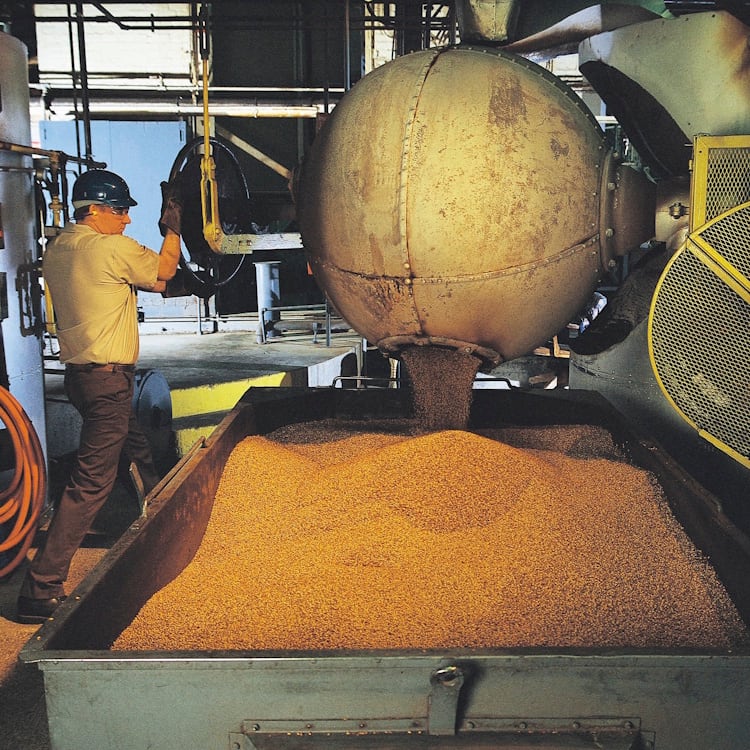Key takeaways:
- With cocoa prices at historic highs, manufacturers are turning to malted barley flour as a cost-saving, clean label extender that helps stabilize both formulations and budgets.
- Malted barley flour offers roasted, cocoa-adjacent flavor and a similar texture profile, allowing bakers and snack makers to reformulate without major processing changes.
- As cocoa volatility becomes a long-term reality, brands are increasingly building barley-based extenders into new product development to future-proof recipes from day one.
If you’ve spent the past year trying to source cocoa without losing your cool – or your margins – you’re not alone. Cocoa prices have climbed to historic highs thanks to a perfect storm of West African crop failures, disease pressure, political instability and battered supply chains. Some manufacturers have simply been priced out; others are facing rationing. Either way, the cocoa crisis has turned formulation into a frantic chess match.
Which is why Briess Malt & Ingredients Co is suddenly very much in the spotlight. The Wisconsin-based malt specialist – one of the oldest maltsters in the US – has seen demand spike for its roasted malted barley flours as bakers and snack makers hunt for reliable, clean label cocoa extenders. Cocoa alternatives aren’t new, but the urgency is. Manufacturers aren’t nibbling around the edges anymore; they’re reengineering formulas and rethinking cost structures.

“It works so well because it has many of the same flavor characteristics,” says Ron Schroder, director of Marketing. Dark-roasted malted barley flour delivers the familiar toasted, chocolate-adjacent notes that cocoa provides, blending easily into bakery and snack applications. Briess has long positioned it as an extender, but with cocoa volatility now at crisis levels, the message is landing.
And the economics speak for themselves. “It’s a significant savings,” says Shawn Kohlmeier, director of Sales for the Food Division. With cocoa running $5-$6 a pound and malted barley flour sitting closer to a dollar, replacing as little as 20% of your cocoa can drop hundreds of thousands – even millions – of dollars back into your P&L. In a market where cocoa availability itself is shaky, that’s not just efficiency; it’s survival.
Why malted barley flour actually works as a cocoa extender

The obvious question: does malted barley flour taste like cocoa? Not exactly – and that’s part of its appeal. Barley brings roundness and warmth, smoothing cocoa’s sharper bitter edges. “You get those strong roasted notes that are characteristic of cocoa,” Schroder explains, “and depending on how much you roast the malt, you can go from brown to black.”
The sweet spot is typically 20%-25% cocoa replacement, though some manufacturers have pushed it to 50% in brownies and high-fat baked goods. Any higher, and the profile leans toward espresso or dark-roast coffee – not necessarily a bad thing, just different. “Start at 20% and go up or down from there,” says Kohlmeier. “Brands with established flavor expectations need to be cautious, but for new product development, you’d be smart to build malted barley flour in from day one.”
Functionally, it behaves much like cocoa. “You get similar texture and mouthfeel,” notes technical sales specialist Kirana Noe. The bonus is that malted barley flour is a natural humectant, so products often gain a richer, fudgier bite – something Briess says customers consistently praise.
And it’s versatile. From crackers to cookies, cakes, donuts, extruded cereal pieces and cocoa-style puffs, the ingredient performs well in anything receiving a heat-based kill step. Most applications use the non-diastatic version, meaning bakers don’t need to adjust processes, hydration or mixing.
Clean label, supply chain stability & why Wisconsin roasting matters

While price is driving the headlines, clean label reformulation is the quieter force reshaping portfolios. With ultra-processed foods (UPFs) dominating news cycles – and The Lancet’s latest report turning up the pressure – manufacturers are looking for ingredients that are minimally processed, familiar and defendable.
Malted barley flour fits that bill neatly. “It’s water, temperature and time. That’s all that’s used to create malt,” says Kohlmeier. It’s whole grain, non-GMO and produced in SQF-certified facilities. Briess has been organic since 1990 – decades before “clean label” became common industry shorthand.
It’s also local. Unlike cocoa, which the US imports in its entirety, Briess sources most of its barley from North American growers, many of them in Wyoming’s Bighorn Basin. The company has direct, long-standing relationships with farmers and maintains a vertically integrated supply chain that gives customers predictable quality and reliable access.
Then there’s the roasting itself. Briess has been roasting malt in Wisconsin since 1953, transitioning from K-ball roasters to modern drum systems. “Roasting is part of our core competency,” says Schroder. This inhouse expertise means customers get consistent flavor, color and performance across batches. In an era when traceability sells – and protects – that level of transparency is a competitive advantage.
Where barley fits into manufacturers’ cocoa strategies

The cocoa crisis isn’t just pushing small tweaks; it’s forcing full-scale reformulation. Kohlmeier says medium and small manufacturers in particular are being rationed by cocoa suppliers – some can’t secure needed volumes at any price. “So they really have to look at what they can build into their formulations to mitigate that risk,” he explains.
Cocoa isn’t expected to return to anything resembling ‘normal’ pricing. The era of $1-$2 per pound is gone. Structural challenges in West Africa will keep supply tight even if prices ease. That’s why manufacturers are hedging with extenders like malted barley flour: it’s cost-effective, simple to integrate and gives R&D teams room to maneuver.
The biggest growth pockets, Briess says, are in cereals, sweet baked goods and snacks – categories that already embrace roasted notes, darker color and richer textures. Noe says brands leaning into those deeper flavor cues often find malted barley flour doesn’t just stretch cocoa; it elevates it. “We’ve gotten comments that it adds a more premium note – more richness and depth.”
The opportunity is even greater for brands starting from scratch. “If you’re developing new products, you really should be utilizing alternatives like malted barley flour in the original build,” says Kohlmeier. “That way it’s part of your profile from day one.”
The technical tricks that actually matter

Briess positions malted barley flour as a simple swap, but there are nuances. Roast level matters most: too light and the profile reads bready; too dark and it drifts into espresso territory. Matching the roast to the cocoa style you’re mimicking – natural, Dutch-processed, extra-dark – is where the technical team steps in.
Granulation tweaks can help depending on application, but the team cautions against converting the flour into a liquid format, which strips away some of the complex roasted flavors that make it such an effective extender.
Ultimately, success comes down to iteration. Testing, tasting and adjusting the percentage lets manufacturers hit the ideal flavor and color target. And because malted barley flour is far more consistent year-to-year than cocoa’s highly variable crop swings, once you lock in a spec, it stays reliable.
As Noe puts it: “If you’re not using malted barley flour, you could be losing out on some major wins – not just for cost, but for flavor.”
The real math + functionality
How 20% barley can shift your P&L
* Cocoa at roughly $5.50/lb vs malted barley flour at around $1.00/lb
* Swap 20% cocoa in a formula using 100,000 lbs a year
* Cocoa-only cost: about $550,000
* After partial replacement: roughly $450,000
* Approximate savings: $100,000 per year for a single SKU
* Multi-line manufacturers can capture hundreds of thousands to millions annually
* Accessible to manufacturers of all sizes, from small bakeries to global CPGs
What malted barley flour actually does in a formula
* Delivers roasted, chocolate-adjacent flavor notes
* Smooths cocoa’s bitterness for a more rounded profile
* Adds natural humectancy for fudgier textures
* Offers whole-grain, minimally processed credentials
* Provides consistent color control, from light brown to deep black
* Performs cleanly in baked goods, snacks and extruded cereals
* Stays stable year-round, avoiding cocoa’s crop-driven volatility





